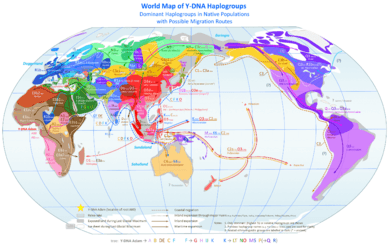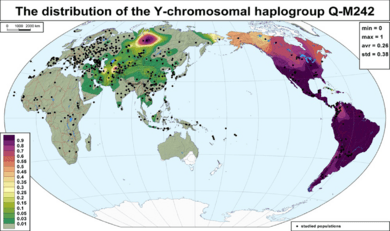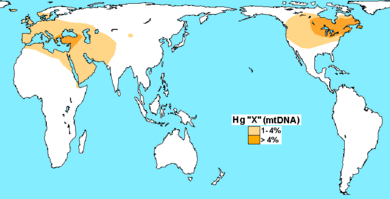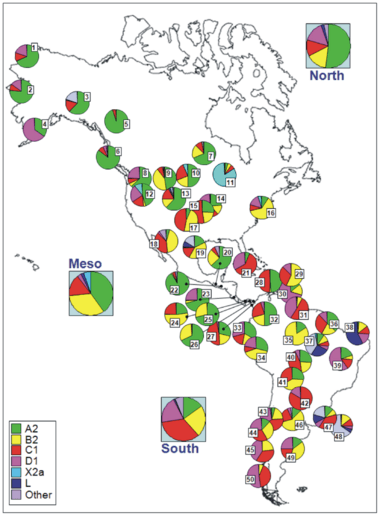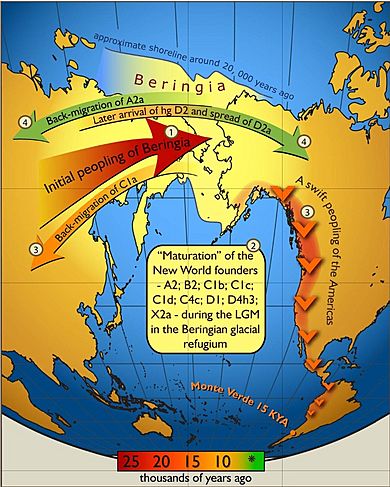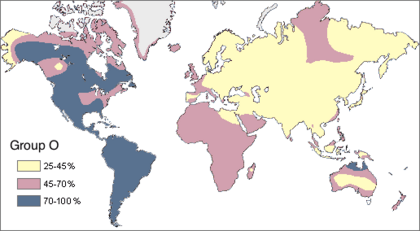Genetic history of the Indigenous peoples of the Americas facts for kids
The genetic history of the Indigenous peoples of the Americas tells us about the journey of the first people who settled in North and South America. This story is split into two main parts: the very first migrations that happened between 20,000 and 14,000 years ago, and what happened after Europeans arrived about 500 years ago. The first period is super important because it set up the basic genetic makeup of today's Indigenous American groups.
Scientists believe that Indigenous American populations came from an ancient East Asian group. This group separated from other East Asian peoples a long time ago, between 36,000 and 25,000 years ago. They then moved into Siberia, where they mixed with another ancient group called Ancient North Eurasians. Later, around 16,000 years ago, they spread across the Americas. Some groups, like those who speak Na-Dene and Eskimo–Aleut languages, have some ancestry from Siberian groups that arrived later.
Studies of genetics in Indigenous American and Siberian populations suggest that the first groups stayed isolated in a land bridge called Beringia for a while. Then, they moved quickly from Siberia through Beringia into the Americas. Genetic patterns in South America show that some Indigenous American groups have been isolated since they first settled there. Groups like the Na-Dene, Inuit, and Native Alaskans have a specific genetic marker called Haplogroup Q-M242. However, they are different from other Indigenous Americans in other genetic ways. This suggests that the people who first settled in the far northern parts of North America and Greenland came from later migrations than those who went further south. Experts in languages and biology have found similar clues from studying Indigenous American languages and blood types.
Contents
Understanding Autosomal DNA
Scientists also study autosomal DNA (atDNA) to understand genetic diversity and how populations are structured in the Americas. Autosomal DNA comes from both parents. When comparing Indigenous American populations to other groups worldwide, they show less genetic diversity. This diversity also decreases the further you get from the Bering Strait, which was likely the entry point from Siberia.
Scientists have noticed that there's more genetic diversity and less clear population structure in western South America compared to eastern South America. This might mean that coastal routes, like along the Pacific Ocean, were easier for people to travel and mix along, compared to routes further inland.
The overall picture suggests that a small number of people (about 70 individuals) first settled the Americas. This group then grew much larger over 800 to 1000 years. The genetic information also shows that there has been some mixing of genes between Asia, the Arctic, and Greenland since the first people arrived in the Americas.
A 2012 study on autosomal DNA said that Indigenous Americans came from at least three main waves of migration from East Asia. Most of their ancestry comes from one main group, called 'First Americans'. However, people who speak Inuit languages in the Arctic got almost half of their ancestry from a second East Asian migration. And those who speak Na-Dene languages got a tenth of their ancestry from a third migration. After the first people settled, they quickly spread south along the west coast. There was little mixing of genes later, especially in South America. One exception is the Chibcha speakers in Colombia, whose ancestry comes from both North and South America.
In 2014, scientists studied the DNA of a 12,500-year-old baby found in Montana. This baby, named Anzick-1, was found near Clovis culture tools. The DNA showed strong links to Siberian groups. It almost completely ruled out any close link to European sources, which was part of a different idea called the "Solutrean hypothesis". The DNA also showed strong links to all existing Indigenous American populations. This means that all of them came from an ancient population that lived in or near Siberia.
Studies of languages have also supported genetic studies. They found connections between languages spoken in Siberia and those spoken in the Americas.
Two genetic studies in 2015 confirmed that Indigenous peoples of the Americas came from Siberia. However, they also found a small genetic link to Australasians (Indigenous peoples of Australia, Melanesia, and the Andaman Islands) among Indigenous peoples in the Amazon region. The migration from Siberia is thought to have happened 23,000 years ago.
A 2018 study looked at Indigenous samples from 11,500 BCE. The genetic evidence suggests that all Indigenous Americans came from a single founding group. This group first split from a 'Basal-East Asian' group in Southeast Asia around 36,000 years ago. This was around the same time that the Jōmon people of Japan also split from Basal-East Asians. The study also showed that the main northern and southern Indigenous American groups, from which all other Indigenous peoples come, separated around 16,000 years ago. An Indigenous American sample from 16,000 BCE in Idaho showed strong genetic links to East Eurasians and Jōmon people from Japan. This confirmed that the ancestors of Indigenous Americans split from an East-Eurasian group somewhere in eastern Siberia.
Another study in the Nature journal in 2018 concluded that Indigenous Americans came from a single founding group. This group first separated from East Asians about 36,000 BCE. Genes continued to flow between these Ancestral Indigenous Americans and Siberians until about 25,000 BCE. Then, they became isolated in the Americas around 22,000 BCE. The northern and southern American Indigenous groups split from each other around 17,500 BCE. There is also some evidence that people moved back from the Americas into Siberia after about 11,500 BCE.
A 2019 study in the Cell journal looked at 49 ancient Indigenous American samples from across North and South America. It concluded that all Indigenous American populations came from one single ancestral group. This group separated from Siberians and East Asians, becoming the Ancestral Indigenous Americans. These then split into the many different Indigenous groups we see today. The study also disagreed with earlier ideas that there might have been two different groups of people settling the Americas. Both Northern and Southern Indigenous Americans are very closely related to each other. They don't show signs of mixing with any earlier, unknown populations.
A review article in the Nature journal in 2021 summarized past genetic studies. It also concluded that all Indigenous Americans came from people who moved from Northeast Asia into the Americas. Once these Ancestral Americans were south of the large ice sheets, they spread out quickly. They branched into many groups, which then led to the main subgroups of Indigenous American populations. This study also disagreed with the idea of a separate, non-Indigenous American population (sometimes called "Paleoamerican"). This idea was based on skull measurements and suggested a link to Indigenous Australians and Papuans.
Overall, the 'Ancestral Native Americans' formed from a group that separated from East Asian people about 36,000 years ago. They then moved north into Siberia. There, they met and mixed with a different ancient Siberian group called Ancient North Eurasians, who are more closely related to modern Europeans. This mixing led to both Indigenous peoples of Siberia and Native Americans.
Y-chromosome DNA: Tracing Paternal Lines
Scientists believe that the male ancestors of the first people who migrated into the Americas came from "Central Siberia."
If a person has the genetic markers Q and C3b on their Y-chromosome, it means they have Indigenous American male ancestry.
The variety and spread of a specific Y-chromosome line in South America suggest that some Indigenous American populations became isolated after they first settled their areas. The Na-Dene, Inuit, and Native Alaskan populations have the haplogroup Q (Y-DNA) marker. However, they are different from other Indigenous Americans in their mitochondrial DNA (mtDNA) and autosomal DNA (atDNA). This suggests that the first people who moved into the far northern parts of North America and Greenland came from later migrations.
Haplogroup Q: The Main Paternal Lineage
Q-M242 is a key genetic marker for Haplogroup Q. In Eurasia, Haplogroup Q is found among Indigenous Siberian populations, like the modern Chukchi and Koryak peoples. It's also found in some Southeast Asian groups, like the Dayak people. Two groups have a very high amount of the Q-M242 marker: the Ket (93.8%) and the Selkup (66.4%). The Ket are thought to be the only survivors of ancient hunter-gatherers in Siberia. Their population is very small, with fewer than 1,500 Ket in Russia. The Selkup have a slightly larger population, with about 4,250 people.
During the Paleo-Indigenous American period, a small group of people carrying the Q-M242 marker migrated to the Americas across the Bering Strait (Beringia). A change happened in one member of this first group, creating a new marker called Q-M3. People with this new marker then spread all over the Americas.
Haplogroup Q-M3 is about 15,000 years old, which is when the first Paleo-Indigenous Americans moved into the Americas. Q-M3 is the most common male genetic marker in the Americas. It's found in 83% of South American populations, 50% of Na-Dene populations, and about 46% of North American Eskimo-Aleut populations. Since there's very little Q-M3 found back in Eurasia, this marker likely developed in eastern Beringia, perhaps in the Seward Peninsula or western Alaskan interior. The Beringia land bridge later became submerged, cutting off land routes.
Since Q-M3 was discovered, scientists have found several smaller groups (subclades) of people who carry it. For example, in South America, some populations have a lot of the M19 marker, which defines the subclade Q-M19. M19 has been found in 59% of Amazonian Ticuna men and 10% of Wayuu men. The M19 subclade seems to be unique to South American Indigenous peoples and appeared 5,000 to 10,000 years ago. This suggests that groups started to become isolated and form tribes soon after they migrated into South America. Other American subclades include Q-L54, Q-Z780, Q-MEH2, Q-SA01, and Q-M346. In Canada, two other lines have been found: Q-P89.1 and Q-NWT01.
Haplogroup R1: European Influence
Haplogroup R1 is the second most common Y-DNA haplogroup found among Indigenous Americans, after Y-DNA haplogroup Q.
At first, there was discussion about where haplogroup R1b in Native Americans came from. Some early studies thought it might have been one of the original Siberian lines of Native Americans. However, this is now considered unlikely. The R1b lines found in Native Americans are usually the same as those in western Europeans. Also, its highest concentration is found among various tribes in eastern North America that don't share the same culture.
So, many experts now believe that R1b was most likely introduced through mixing with Europeans after they settled North America starting in 1492.
R1 (M173) is mostly found in North American groups like the Ojibwe (50-79%), Seminole (50%), Sioux (50%), Cherokee (47%), Dogrib (40%), and Tohono O'odham (Papago) (38%). It's most common in northeastern North America and becomes less frequent as you go from east to west. In southwestern Native American tribes, this haplogroup is as low as 4%.
Haplogroup C-P39: A Link to Na-Dene Speakers
Haplogroup C-M217 is mainly found in Indigenous Siberians, Mongolians, and Kazakhs. It is the most common and widespread branch of the larger (Y-DNA) haplogroup C-M130. A descendant of Haplogroup C-M217, called C-P39, is most commonly found in today's Na-Dene speakers. It's most frequent among the Athabaskans at 42%, and less common in some other Indigenous American groups. This unique and separate branch, C-P39, includes almost all the Haplogroup C-M217 Y-chromosomes found among all Indigenous peoples of the Americas.
Some researchers think this might mean that the Na-Dene migration happened from the Russian Far East after the first Paleo-Indigenous American settlement, but before the more recent expansions of modern Inuit, Inupiat, and Yupik peoples.
Besides Na-Dene peoples, haplogroup C-P39 (C2b1a1a) is also found among other Indigenous Americans, such as those speaking Algonquian and Siouan languages. C-M217 is also found among the Wayuu people of Colombia and Venezuela.
Genetic Data for Indigenous Groups
Here is a table showing the Y-chromosome DNA haplogroups found in various Indigenous peoples of the Americas. The percentages show how common each haplogroup is in the studied groups.
| Group | Language | Place | n | C | Q | R1 | Others | Reference |
|---|---|---|---|---|---|---|---|---|
| Algonquian | Algic | Northeast North America | 155 | 7.7 | 33.5 | 38.1 | 20.6 | Bolnick 2006 |
| Apache | Na-Dene | SW United States | 96 | 14.6 | 78.1 | 5.2 | 2.1 | Zegura 2004 |
| Athabaskan | Na-Dene | Western North America | 243 | 11.5 | 70.4 | 18.1 | Malhi 2008 | |
| Cherokee | Iroquoian | SE United States | 62 | 1.6 | 50.0 | 37.1 | 11.3 | Bolnick 2006 |
| Cherokee | Iroquoian | Eastern North America | 30 | 50.0 | 46.7 | 3.3 | Malhi 2008 | |
| Cheyenne | Algic | United States | 44 | 16 | 61 | 16 | 7 | Zegura 2004 |
| Chibchan | Macro-Chibchan | Panama | 26 | 100 | Zegura 2004 | |||
| Chipewyan | Na-Dene | Canada | 48 | 6 | 31 | 62.5 | Bortoloni 2003 | |
| Chippewa | Algic | Eastern North America | 97 | 4.1 | 15.9 | 50.5 | 29.9 | Bolnick 2006 |
| Dogrib | Na-Dene | Canada | 15 | 33 | 27 | 40 | Malhi 2008 | |
| Dogrib | Na-Dene | Canada | 37 | 35.1 | 45.9 | 8.1 | 10.8 | Dulik 2012 |
|
Gê |
Macro-Jê | Brazil | 51 | 92 | 8 | Bortoloni 2003 | ||
| Guaraní | Tupian | Paraguay | 59 | 86 | 9 | 5 | Bortoloni 2003 | |
| Inga | Quechua | Colombia | 11 | 78 | 11 | 11 | Bortoloni 2003 | |
| Inuit | Eskimo–Aleut | North American Arctic | 60 | 80.0 | 11.7 | 8.3 | Zegura 2004 | |
| Inuvialuit | Eskimo–Aleut | Canada | 56 | 1.8 | 55.1 | 33.9 | 8.9 | Dulik 2012 |
| Mayan | Mesoamerica | 71 | 87.3 | 12.7 | Zegura 2004 | |||
| Mixe | Mixe–Zoque | Mexico | 12 | 100 | Zegura 2004 | |||
| Mixtec | Oto-Manguean | Mexico | 28 | 93 | 7 | Zegura 2004 | ||
| Muskogean | Muskogean | SE United States | 36 | 2.8 | 75 | 11.1 | 11.1 | Bolnick 2006 |
| Nahua | Uto-Aztecan | Mexico | 17 | 94 | 6 | Malhi 2008 | ||
| Native Americans (United States) |
United States | 398 | 9.0 | 58.1 | 22.2 | 10.7 | Hammer 2005 | |
| Navajo | Na-Dene | SW United States | 78 | 1.3 | 92.3 | 2.6 | 3.8 | Zegura 2004 |
| Indigenous North Americans | North America | 530 | 6.0 | 77.2 | 12.5 | 4.3 | Zegura 2004 | |
| Papago | Uto-Aztecan | SW United States | 13 | 61.5 | 38.5 | Malhi 2008 | ||
| Seminole | Muskogean | Eastern North America | 20 | 45.0 | 50.0 | 5.0 | Malhi 2008 | |
| Sioux | Macro-Siouan | Central North America | 44 | 11 | 25 | 50 | 14 | Zegura 2004 |
| South America | Amerindian | South America | 390 | 92 | 4 | 4 | Bortoloni 2003 | |
| Tanana | Na-Dene | Northwest North America | 12 | 42 | 42 | 8 | 8 | Zegura 2004 |
| Ticuna | Ticuna–Yuri | West Amazon basin | 33 | 100 | Bortoloni 2003 | |||
| Tlingit | Na-Dene | Pacific Northwest | 11 | 18 | 82 | Dulik 2012 | ||
| Tupí–Guaraní | Tupian | Brazil | 54 | 100 | Bortoloni 2003 | |||
| Uto-Aztecan | Uto-Aztecan | Mexico, Arizona | 167 | 93.4 | 6.0 | Malhi 2008 | ||
| Warao | Warao (isolate) | Caribbean South America | 12 | 100 | Bortoloni 2003 | |||
| Wayúu | Arawakan | Guajira Peninsula | 19 | 69 | 21 | 10 | Bortoloni 2003 | |
| Wayúu | Arawakan | Guajira Peninsula | 25 | 8 | 36 | 44 | 12 | Zegura 2004 |
| Yagua | Peba–Yaguan | Peru | 7 | 100 | Bortoloni 2003 | |||
| Yukpa | Cariban | Colombia | 12 | 100 | Bortoloni 2003 | |||
| Zapotec | Oto-Manguean | Mexico | 16 | 75 | 6 | 19 | Zegura 2004 | |
| Zenú | extinct | Colombia | 30 | 81 | 19 | Bortoloni 2003 |
Mitochondrial DNA: Tracing Maternal Lines
Scientists have long known that certain mitochondrial DNA (mtDNA) haplogroups (A, B, C, D, and X) are common in both East Asian and Indigenous American populations. mtDNA is passed down only from the mother. The highest number of these four Indigenous American haplogroups is found in the Altai-Baikal region of southern Siberia. Some smaller groups (subclades) of C and D that are similar to Indigenous American ones are found among Mongolian, Amur, Japanese, Korean, and Ainu populations. A 2023 DNA study found that northern coastal China also contributed to the genes of Native Americans and Japanese people.
When studying human mitochondrial DNA haplogroups, results show that Indigenous American haplogroups, including haplogroup X, all came from a single founding East Asian population. It also shows that the way mtDNA haplogroups are spread and how different they are among groups with similar languages came from many earlier migrations from the Bering Strait region. All Indigenous American mtDNA can be traced back to five main haplogroups: A, B, C, D, and X. More specifically, Indigenous American mtDNA belongs to smaller groups like A2, B2, C1b, C1c, C1d, D1, and X2a (with smaller groups C4c, D2a, and D4h3a). This means that 95% of Indigenous American mtDNA comes from a very small group of founding women. The remaining 5% is made up of the X2a, D2a, C4c, and D4h3a subgroups.
X is one of the five mtDNA haplogroups found in Indigenous Americans. Native Americans mostly have the X2a group, which has never been found in the Old World. According to Jennifer Raff, X2a probably came from the same Siberian population as the other four founding maternal lines.
Haplogroup X genetic sequences split about 20,000 to 30,000 years ago into two subgroups, X1 and X2. X2's subgroup X2a is found in only about 3% of the total current Indigenous population of the Americas. However, X2a is a major mtDNA subgroup in North America. Among the Algonquian peoples, it makes up to 25% of their mtDNA types. It's also found in smaller percentages to the west and south of this area. For example, among the Sioux (15%), the Nuu-chah-nulth (11%–13%), the Navajo (7%), and the Yakama (5%). The main idea for X2a appearing in North America is that it migrated along with the A, B, C, and D mtDNA groups, from a source in the Altai Mountains of central Asia. Haplotype X6 was found in the Tarahumara (1.8%) and Huichol (20%).
Studying the mitochondrial DNA from ancient Paleo-Eskimo remains (3,500 years old) shows they are different from modern Indigenous Americans. They fall into the D2a1 subgroup, which is seen among today's Aleutian Islanders, the Aleut, and Siberian Yupik populations. This suggests that the people who settled the far north, and later Greenland, came from later coastal populations. Then, about 800–1,000 years ago, a genetic exchange happened in the northern areas. This was brought by the Thule people (proto-Inuit). These last pre-Columbian migrants introduced haplogroups A2a and A2b to the existing Paleo-Eskimo populations of Canada and Greenland, leading to the modern Inuit.
A route through Beringia is seen as more likely than the Solutrean hypothesis, which suggested a European origin. A summary in a 2012 science journal stated that similarities in the ages and locations of C4c and X2a lineages support the idea of two origins for Paleo-Indigenous Americans. Since C4c clearly comes from Asia, finding that C4c and X2a have similar genetic histories definitely rules out the idea of an Atlantic route into North America.
Another study, also focusing on mtDNA (passed down from mothers), showed that the Indigenous people of the Americas have maternal ancestry from a few founding groups in East Asia. These groups would have arrived via the Bering Strait. According to this study, it is probable that the ancestors of the Indigenous Americans would have remained for a time in the region of the Bering Strait. After that, there would have been a rapid movement of people settling the Americas, taking the founding genetic lines all the way to South America.
According to a 2016 study on mtDNA lineages, "a small population entered the Americas via a coastal route around 16,000 years ago. This happened after they had been isolated in eastern Beringia for about 2,400 to 9,000 years, following their separation from eastern Siberian populations. After moving quickly throughout the Americas, limited gene flow in South America led to a clear genetic structure of populations, which stayed the same over time. All the ancient mitochondrial lineages found in this study were missing from modern data. This suggests that many ancient lineages died out. To understand this better, scientists used a new test. The analysis supported the idea that European colonization caused a big loss of pre-Columbian genetic lines."
Genetic Mixing: How Groups Blended
Ancient Beringians: A Key Ancestral Group
New discoveries in Alaska have shown that there was an unknown Indigenous American population called "Ancient Beringians." While most archaeologists agree that early settlers crossed into Alaska from Russia over the Bering Strait land bridge, there's a big debate about whether there was one founding group or several waves of migration. In 2018, scientists sequenced the DNA of an Indigenous girl whose remains were found in Alaska in 2013. Her DNA did not match the two known branches of Indigenous Americans. Instead, it belonged to the early Ancient Beringian population. This discovery is important because it's the first direct genetic proof that there might have been only one main wave of migration into the Americas. The genetic branching and division happened after that. This migration wave is thought to have happened about 20,000 years ago. The Ancient Beringians are believed to be a common ancestral group for today's Indigenous American populations. This is different from earlier research that suggested modern populations came from separate Northern and Southern branches. Experts also used wider genetic evidence to figure out that the split between the Northern and Southern American branches from the Ancient Beringians in Alaska happened only about 17,000 and 14,000 years ago. This further challenges the idea of multiple migration waves at the very beginning of settlement.
Genetic evidence for Paleo-Indigenous Americans includes signs of mixing with older Sundadont genetic lines in remote populations in the South American rainforest, and in the genes of Patagonians-Fuegians.
Nomatto et al. (2009) suggested that migration into Beringia happened between 40,000 and 30,000 years ago. A migration into the Americas before the Last Glacial Maximum (LGM) was then followed by the northern population becoming isolated when the ice-free corridor closed.
A 2016 genetic study of Indigenous peoples in the Amazon region of Brazil showed evidence of mixing from a separate line of an unknown ancient people. This ancient group seems to be related to modern "Australasian" peoples (like Aboriginal Australians and Melanesians). This "Ghost population" was found in people who speak Tupian languages. They temporarily named this ancient group "Population Y," after Ypykuéra, which means 'ancestor' in the Tupi language family. However, a 2021 genetic study disagreed with the idea of an Australasian part in Indigenous American ancestry. The signal that looked like Australasian ancestry could also be explained by the Basal-East Asian Tianyuan man sample. So, it doesn't represent "real Australasian affinity." The authors explained that earlier claims of possible Australasian ancestry were based on a misunderstood genetic echo. This echo was actually early East-Eurasian gene flow (from the 40,000 BCE old Tianyuan sample) into Aboriginal Australians and Papuans, which was later lost in modern East Asians.
Archaeological evidence for humans being in the Americas before the LGM was first shown in the 1970s, notably with the "Luzia Woman" skull found in Brazil.
Mixing with Old World Populations
A lot of mixing between different groups has happened during and since the European colonization of the Americas.
South and Central America
In Latin America, a lot of mixing happened between Indigenous American populations, European settlers, and people from Sub-Saharan Africa who were brought as slaves. From about the 1700s, a special set of terms developed in Latin America to describe the different combinations of mixed ancestry.
Many people who say they belong to one group actually have genetic evidence of having ancestors from several different groups. The European conquest of South and Central America, starting in the late 1400s, was first done by male soldiers and sailors from Spain and Portugal. These new soldier-settlers had children with Indigenous American women and later with African slaves. These children of mixed ancestry were often called "Castas" by the Spanish and Portuguese settlers.
North America
The North American fur trade in the 1500s brought many more European men from France, Ireland, and Great Britain. These men often married Indigenous North American women. Their children became known as "Métis" or "Bois-Brûlés" by the French settlers. The English and Scottish settlers called them "mixed-bloods," "half-breeds," or "country-born"'.
Indigenous Americans in the United States are more likely than other groups to marry someone from a different background. This has led to a decreasing percentage of Indigenous ancestry among those who identify as Indigenous American. In the United States 2010 census, almost 3 million people said their race was Indigenous American (including Alaskan Native). This is based on how people identify themselves, and there are no official rules for this. A lot of people identified as having Cherokee ancestry. This is sometimes called the "Cherokee Syndrome", where some Americans believe they have a "long-lost Cherokee ancestor" but can't find that person in their family tree. This is often about choosing an identity that feels good or important. Indigenous American identity in the Eastern United States is often not strongly linked to genetic ancestry. It is especially embraced by people who are mostly of European descent. Some tribes have set rules to protect their heritage, often using a Certificate of Degree of Indian Blood. They sometimes remove members who cannot provide proof of Indigenous American ancestry. This has become a debated topic in Native American reservation politics.
European Diseases and Genetic Changes
A team led by Ripan Malhi, an anthropologist, studied how European diseases affected the genes of Indigenous Americans. They used a scientific method called whole exome sequencing to test genes related to the immune system. By looking at ancient and modern Indigenous DNA, they found that a gene variant called HLA-DQA1 was present in almost 100% of ancient remains. This gene helps the body tell the difference between healthy cells and invading viruses and bacteria. However, this variant was found in only 36% of modern Indigenous Americans. These findings suggest that European diseases like smallpox changed the disease environment in the Americas. Survivors of these outbreaks were less likely to carry variants like HLA-DQA1, which made them less able to fight new diseases. Scientists estimate that this genetic change happened around 175 years ago, when the smallpox epidemic was widespread in the Americas.
Blood Groups: Another Genetic Clue
Prior to the 1952 confirmation of DNA as the hereditary material by Alfred Hershey and Martha Chase, scientists used blood proteins to study human genetic variation. The ABO blood group system was discovered by the Austrian Karl Landsteiner in 1900, who found three different blood types. Blood groups are inherited from both parents. The ABO blood type is controlled by a single gene (the ABO gene) with three variations: i, IA, and IB.
Research during World War I found that the amounts of blood groups A, B, and O were very different from one region to another. The "O" blood type (which usually means both A and B genes are missing) is very common worldwide, found in 63% of all human populations. Type "O" is the main blood type among Indigenous populations of the Americas, especially in Central and South American groups, where it's almost 100% common. In Indigenous North American populations, the frequency of type "A" ranges from 16% to 82%. This suggests again that the first Indigenous Americans came from a small, isolated group of people.
The usual explanation for such a high number of Indigenous Americans having blood type O is genetic drift. Because the ancestral population of Indigenous Americans was small, the variety of blood types could have been reduced over generations due to the founder effect. Other related explanations include the Bottleneck explanation. This states that there were high numbers of blood type A and B among Indigenous Americans, but a huge population decline in the 1500s and 1600s, caused by diseases from Europe, led to massive deaths of those with blood types A and B. By chance, a large number of the survivors were type O.
| PEOPLE GROUP | O (%) | A (%) | B (%) | AB (%) |
|---|---|---|---|---|
| Blackfoot Confederacy (Indigenous North American) | 17 | 82 | 0 | 1 |
| Bororo (Brazil) | 100 | 0 | 0 | 0 |
| Eskimos (Alaska) | 38 | 44 | 13 | 5 |
| Inuit (Eastern Canada & Greenland) | 54 | 36 | 23 | 8 |
| Hawaiians (Polynesians, non-Indigenous American) | 37 | 61 | 2 | 1 |
| Indigenous North Americans (as a whole Native Nations/First Nations) | 79 | 16 | 4 | 1 |
| Maya (modern) | 98 | 1 | 1 | 1 |
| Navajo | 73 | 27 | 0 | 0 |
| Peru | 100 | 0 | 0 | 0 |
The Dia antigen of the Diego antigen system has been found only in Indigenous peoples of the Americas and East Asians, and in people with some ancestry from those groups. The frequency of the Dia antigen in various groups of Indigenous peoples of the Americas ranges from almost 50% to 0%. Differences in the frequency of the antigen in populations of Indigenous people in the Americas correlate with major language families, modified by environmental conditions.
See also
 In Spanish: Historia genética de los indígenas de América para niños
In Spanish: Historia genética de los indígenas de América para niños
- Introduction to genetics
- Archaeogenetics
- Archaeology of the Americas
- Ancient DNA
- Clovis culture
- Early human migrations
- Genetic history of Africa
- Genetic history of Europe
- Genetic history of Italy
- Genetic history of North Africa
- Genetic history of the British Isles
- Genetic history of the Iberian Peninsula
- Genetic history of the Middle East
- Genetics and archaeogenetics of South Asia
- List of haplogroups of historic people
- Race and genetics
- Settlement of the Americas#Genomic age estimates
- List of Y-chromosome haplogroups in populations of the world



